#Build8
Explore tagged Tumblr posts
Link
0 notes
Text
Picea abies

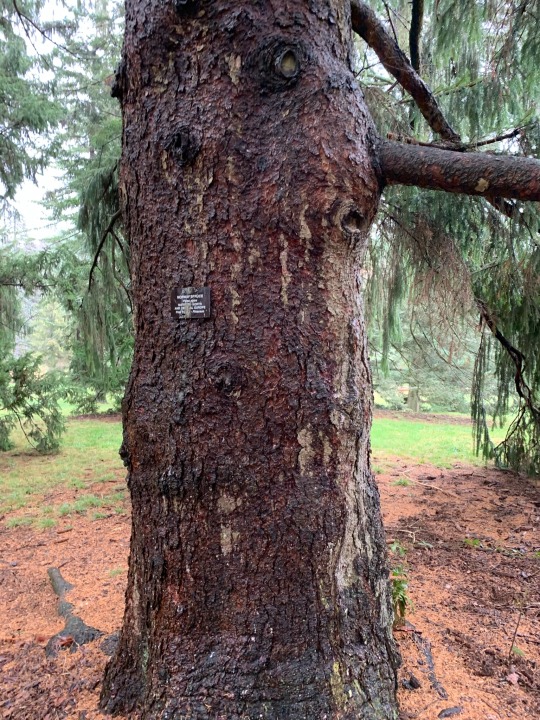


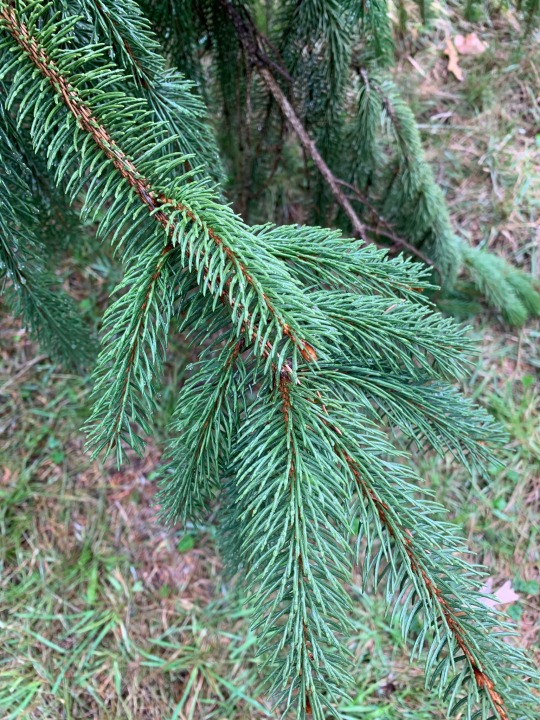
Norway Spruce
Picea abies
Type: Needled evergreen Family: Pinaceae Native Range: Europe Zone: 2 to 7 Height: 40-60 feet Spread: 25-30 feet Bloom Time: Non-flowering Bloom Description: Non-flowering Sun: Full sun Water: Medium Maintenance: Low
BUILD/BEAUTY
This coniferous tree is located at the Arnold Arboretum, high up on the evergreen hill. The Norway pine is a great looking tree, and this specimen is no exception. The needles of this tree are arranged in a cylinder type formation, encompassing the entire twig 360 degrees around. It very well may have been just the lighting but these needles appeared waxy and blue green under the overcast skies. The needles look great and earn a 3 out of 4 for its category. The bark, similar to that of many other pines, is reddish hued, and plated. Also to note, this tree gives off plenty of resin, which can be seen on the placard. I will award a 2 out of 3 for the bark. For landscape uniqueness, this tree gets a 2 out of 3, as the tall airy form works well in this landscape among other conifers, but would also look real cool by its self in a field. The combined score the Norway Spruce gets is a 7 out of 10 for beauty.
Bark: (1-3) 2
Leaves: (1-4) 3
Landscape uniqueness: (1-3) 2
Total: 7
The Norway Spruce’s wood is relatively soft, at only 380lbs on the Janka hardness scale. The wood is easily workable but you need straight lumber and grains to avoid a tear out. The wood doesn’t stain well due to the closed pore structure. The main uses of this tree include paper, construction lumber, Christmas trees, and musical instruments. The wood is used in framing construction, in that it has good compressible strength, and hard wood isn’t essential for that. This tree does have some construction benefits, so It will be receiving a rating of 8 out of 10 for buildability.
Source:
1. https://www.arborday.org/Trees/TreeGuide/treedetail.cfm?itemID=924
2. https://www.mortonarb.org/trees-plants/tree-plant-descriptions/norway-spruce
3. http://www.missouribotanicalgarden.org/PlantFinder/PlantFinderDetails.aspx?kempercode=e620
4. https://www.wood-database.com/norway-spruce/
0 notes
Photo

創動 仮面ライダービルド BUILD8 Feat.装動 仮面ライダーエグゼイド レビュー
New Post has been published on http://shokuganreview.com/shokugan/sodo-kamenriderbuild-build8/
0 notes
Text
【食玩】「創動 仮面ライダービルド BUILD8 」ラインナップ公開
【食玩】「創動 仮面ライダービルド BUILD8 」ラインナップ公開
ラインナップ公開
(more…)
View On WordPress
0 notes
Text
【食玩ビルドFACTORY vol.31】発売直前 創動BUILD7!! BUILD8ラインナップを完全公開!!
このサイトの記事を見る
View On WordPress
0 notes
Text
「創動 仮面ライダービルド BUILD8 Feat.装動 仮面ライダーエグゼイド」のゲンム ゴッドマキシマムはキースラッシャー付き! https://t.co/u0GjUk7Kqi
「創動 仮面ライダービルド BUILD8 Feat.装動 仮面ライダーエグゼイド」のゲンム ゴッドマキシマムはキースラッシャー付き! https://t.co/u0GjUk7Kqi
— 少佐 (@DawnPer76892244) March 19, 2018
0 notes
Text
Cryptomeria japonica
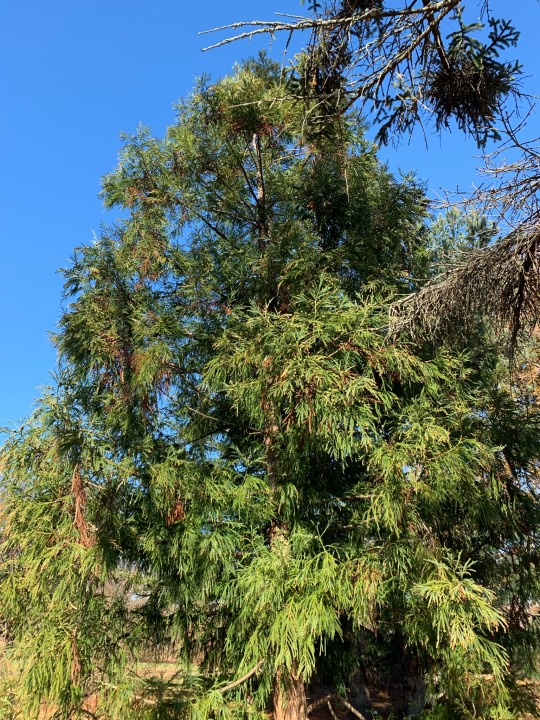
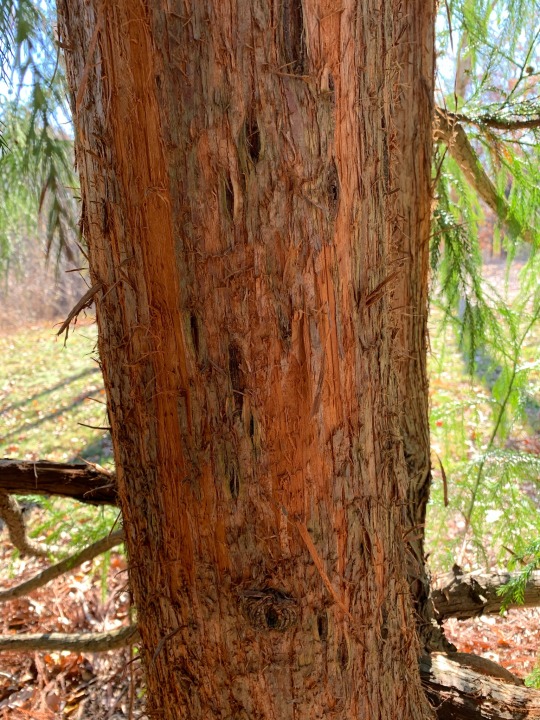
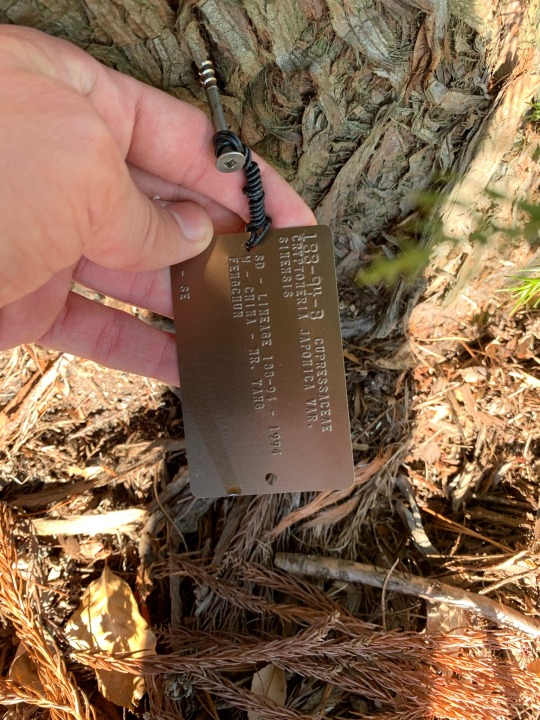
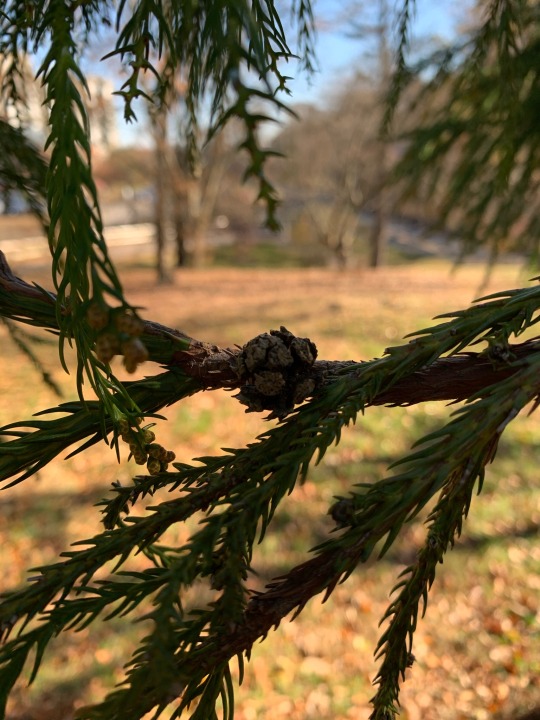

Japanese Cedar
Cryptomeria japonica
Type: Needled evergreen Family: Cupressaceae Native Range: Japan, southern China Zone: 5 to 9 Height: 50.00 to 60.00 feet Spread: 20.00 to 30.00 feet Bloom Time: Non-flowering Bloom Description: Non-flowering Sun: Full sun Water: Medium Maintenance: Low Leaf: Evergreen
This tree was one of the last trees that I logged as I was leaving the Arnold Arboretum, and it caught my eye due to its soft looking branches. Upon further inspection this tree was in fact pretty soft, its needles were small at around 1/4″ and formed these tendril like fronds that draped well over the tree. The bark has some typical cedar qualities with how it flakes, and is multi colored, so it scored well for the Bark category. The needles were in the middle of the road scoring wise, as they appeared soft but were typical of many evergreens. The uniqueness in the landscape stood out as well, this tree had great form. See the scoring below, for a respectable 8 out of 10.
Bark: (1-3) 3
Leaves: (1-4) 2
Landscape uniqueness: (1-3) 3
Total: 8
The building qualities of this tree are similar to that of many other cedars, such as the common red cedar. This tree is the national tree of japan, and has been used much throughout Japanese history traditionally. It has an impressive strength to weight ratio, and commonly was used as a structural member in many applications of early Japanese architecture. As of most cedars, it is very water resistant and does well in ship building, or pier making. The impressive qualities makes this wood score highly at a 8 out of 10. This might be one of the highest combined scores we have had so far.
Source:
1. http://www.missouribotanicalgarden.org/PlantFinder/PlantFinderDetails.aspx?kempercode=a158
2. https://www.rarewoodsusa.com/product/cedar-japanese/
3. http://www.hort.uconn.edu/plants/detail.php?pid=150
0 notes
Text
Cedrus libani
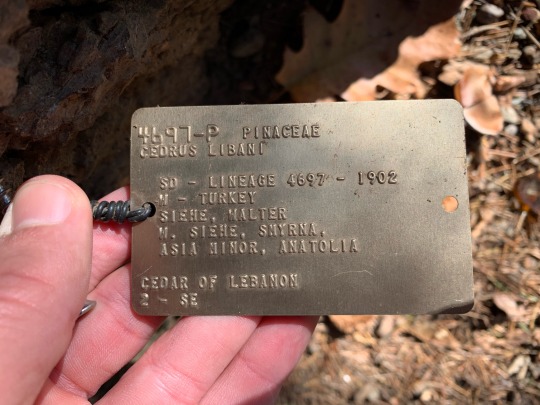
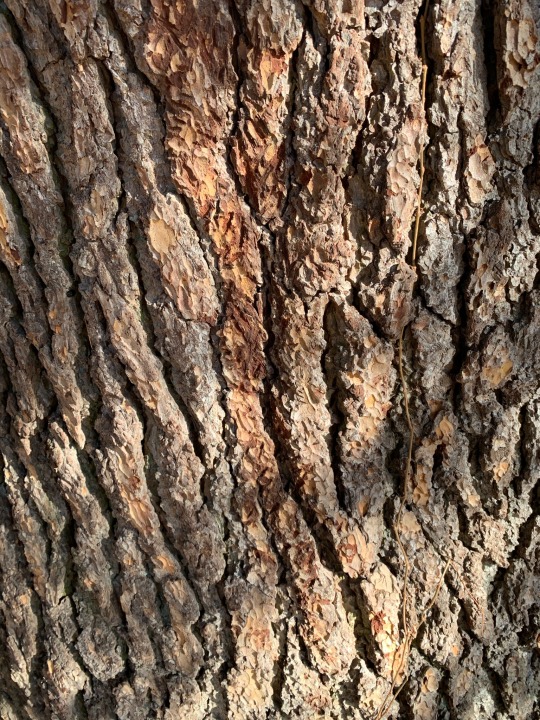
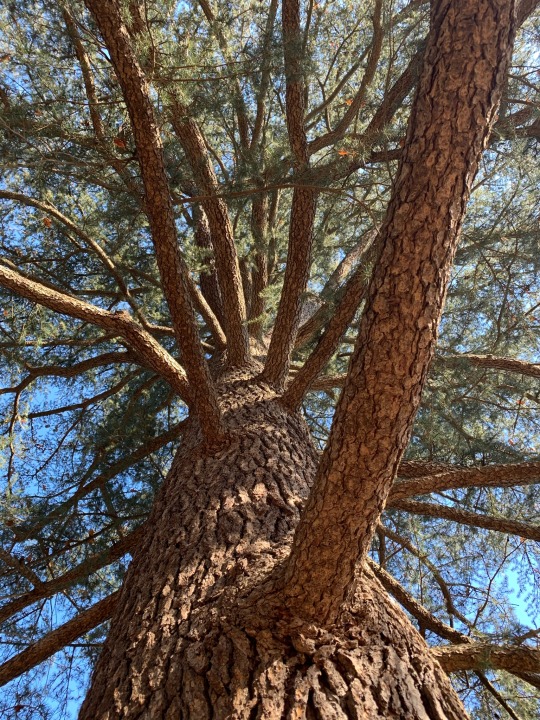
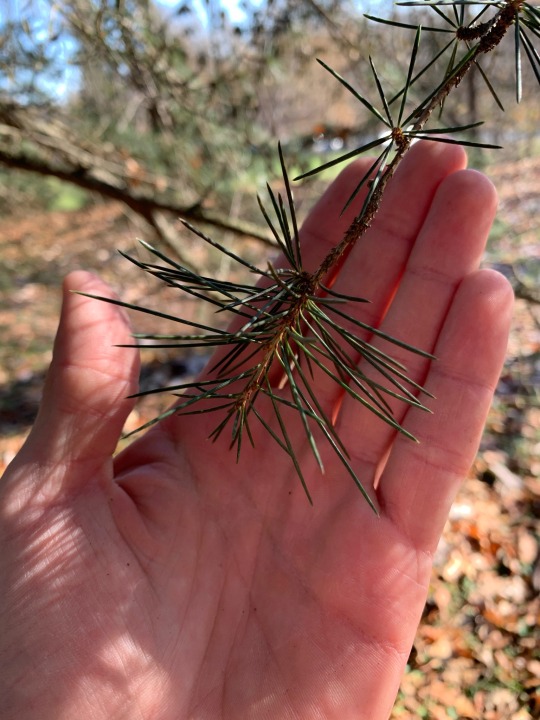
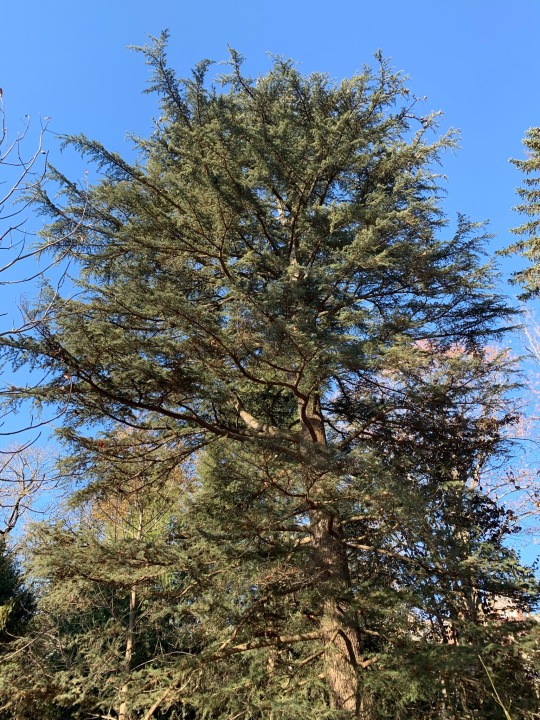
Cedar of Lebanon
Cedrus libani
Type: Needled evergreen Family: Pinaceae Native Range: Southwestern Asia, Syria Zone: 6 to 7 Height: 40.00 to 60.00 feet Spread: 40.00 to 60.00 feet Bloom Time: Non-flowering Bloom Description: Non-flowering Sun: Full sun Water: Medium Maintenance: Medium
BUILD/BEAUTY
The Cedar of Lebanon, commonly known for its position on the Lebanese flag, is a large coniferous tree that doesn’t look much like any other tree. It looks like a mix between a deciduous tree that happens to grow needles. This example in the Arnold Arboretum is a bad example of this but in other pictures it shows better. The bark like many cedars and pines has plates with pretty thick valleys between them, getting a 1 out of 3. The needles are pretty cool, being long, sharp, and a waxy off green. They gained a score of 3 out of 4 for this. The landscape uniqueness is a 3 out of 3, due to its shape, color, and form. They look great as ornamental trees.
Bark: (1-3) 1
Leaves: (1-4) 3
Landscape uniqueness: (1-3) 3
Total: 7
The wood of the Cedar of Lebanon is a middle of the road tree for hardness scoring an 820lb on the janka hardness scale. This wood is generally pretty easy to work with, and glues/finishes well. The wood is very rot resistant, and its most common uses include veneer, cabinetry, building construction, and turned objects. This tree like many other conifers, does a great job as a construction material, providing straight dimensional lumber. The MOE of this tree is 1,465,000 lbf/in2, which isn’t a bad score, its in the middle of the road. This wood is known for its usage in king solomons temple, so you have to know its good. This tree isn’t used as widely as it was in days of past, so it gets a score of 8 out of 10, still respectable.
Source:
1. https://www.wood-database.com/cedar-of-lebanon/
2. http://www.missouribotanicalgarden.org/PlantFinder/PlantFinderDetails.aspx?kempercode=b431
3. https://www.thespruce.com/cedar-of-lebanon-growing-tips-3269305
0 notes
Text
Tsuga heterophylla

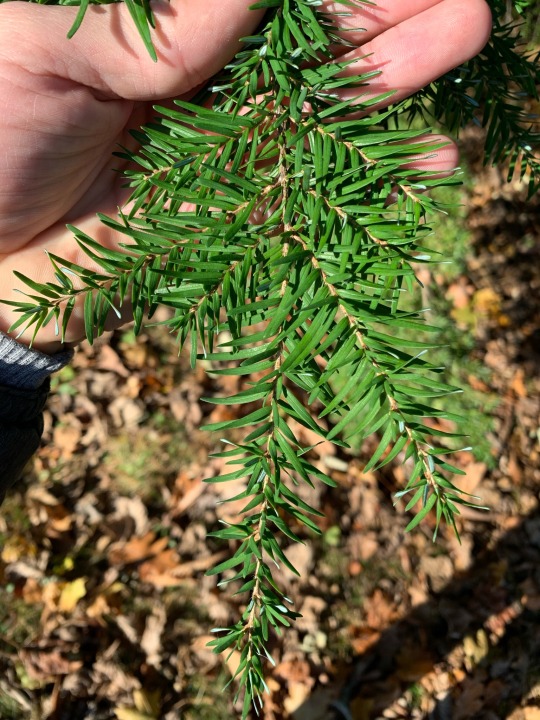

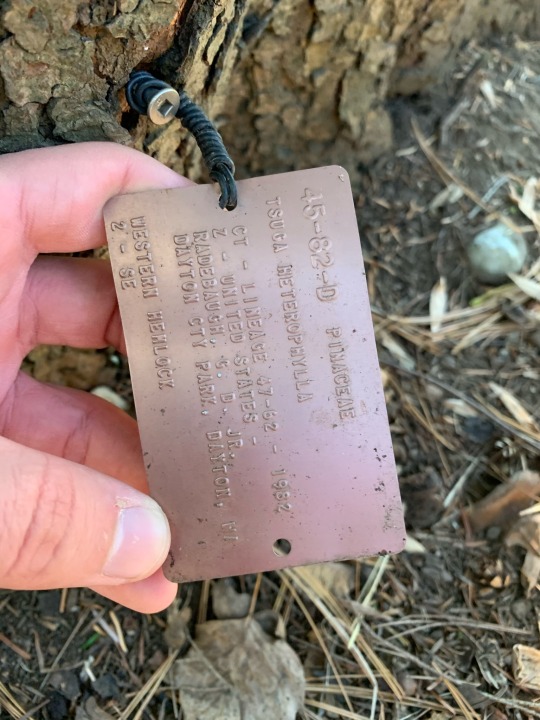

Western Hemlock
Tsuga heterophylla
Type: Needled evergreen Family: Pinaceae Native Range: North America Zone: 3 to 7 Height: 40.00 to 70.00 feet Spread: 25.00 to 35.00 feet Bloom Time: Non-flowering Bloom Description: Non-flowering Sun: Part shade to full shade Water: Medium Maintenance: Low
BUILD/BEAUTY
The Western hemlock, like its eastern cousin, is an especially tall evergreen that maintains the classic Christmas tree conical shape. This tree’s needles are a bit more cylindrical arranged like the eastern hemlock, although the needles are still flat. I will award a 1 out of 4 for leaves/needles. The bark is similar to that of other pines and hemlocks, the bark is plated with wide valleys between them. The bark gets a 1 out of 3. For landscape uniqueness, this tree’s general form and shape do wonders for it, in that it scores a 2 out of 3 due to its wispy arms and drooping twigs. Total score for beauty is 4 out of 10
Bark: (1-3) 1
Leaves: (1-4) 1
Landscape uniqueness: (1-3) 2
Total: 4
Western Hemlock wood is relatively soft, at only 540lbs on the janka hardness scale. The wood is easy to work, although there is a significant difference between the hard wood and soft wood, so you have to be careful when sanding that you don’t make too big of a dent in the soft bits. Some of the most common uses for this wood include boxes, pallets, crates, plywood, framing, and other construction purposes. Some dimensional lumber can be made from this tree, as well as timbers for structure, earning a relatively high score of 8 out of 10 for buildability. The Western hemlock, like many of its coniferous brothers, scored well here.
Source:
1. https://www.wood-database.com/western-hemlock/
2. https://plants.usda.gov/plantguide/pdf/cs_tshe.pdf
3. http://www.missouribotanicalgarden.org/PlantFinder/PlantFinderDetails.aspx?kempercode=g100
0 notes
Text
Carya ovata

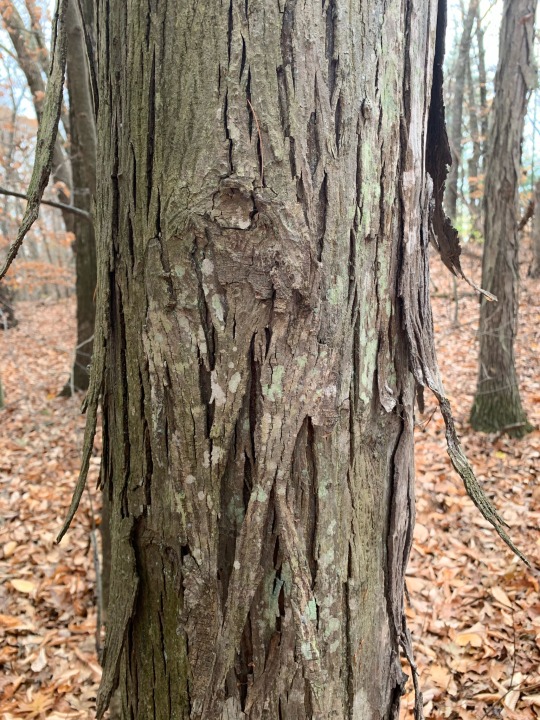
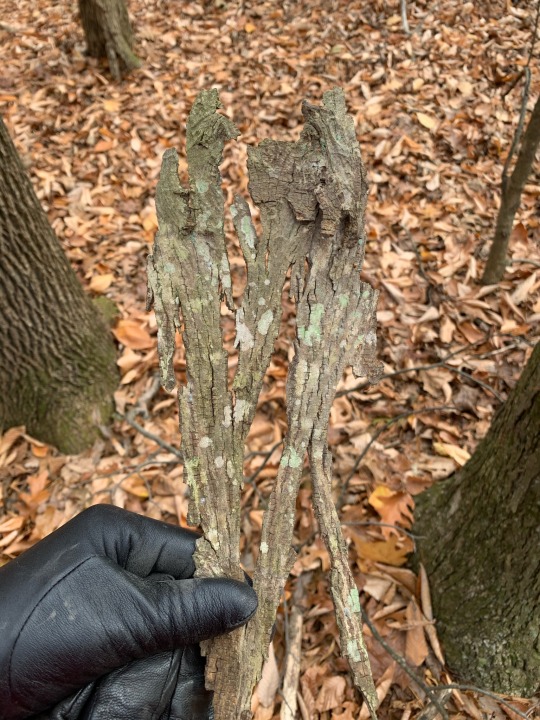
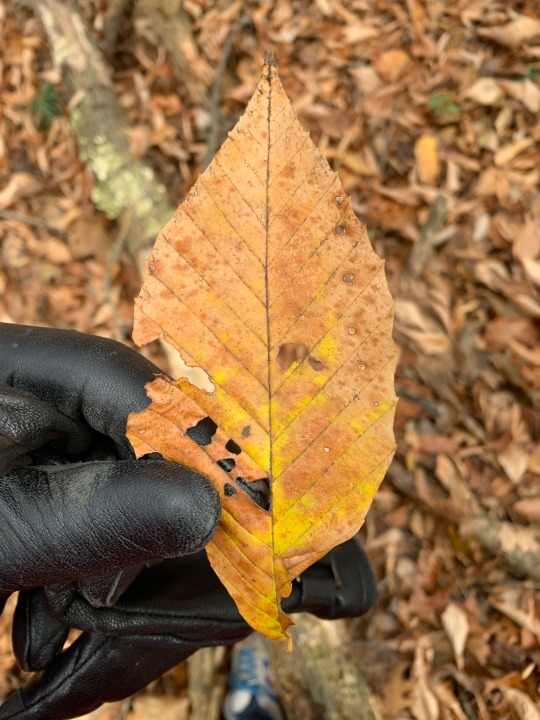
Shagbark Hickory
Carya ovata
Tree or Plant Type: Tree Foliage: Deciduous Native Locale: Chicago area, Illinois, North America Size Range: Large tree Mature Height: 60-80 feet Mature Width: 30-50 feet Light Exposure: Full sun, Partial sun/shade Hardiness Zones: Zone 4-9
BUILD/BEAUTY
This shag bark hickory I have found on a trail in the Boxford town forest. This Specimen is a middle aged example, as seen from its trunk only being around a foot across. The most striking aspect of these trees is its bark. The flaky, crumbly looking bark runs up the entire length of the tree, peeling off at the bottom like its shedding a layer. The bark reminds me of some mushrooms, whose stalks have this shaggy appearance to them as well. This trees best rating was its bark, with a 3 out of 3, and the leaves, while being quite simple, a 1 out of 4. For landscape uniqueness, the shag bark gains some points, as this unique and different bark can really catch your eye in a landscape.
Bark: (1-3) 3
Leaves: (1-4) 1
Landscape uniqueness: (1-3) 2
Total: 6
The Building properties of this wood are similar to that of other hickories, where its extremely tough and hard. The janka hardness rating is 1,880lbs of force for this wood. The wood makes great uses in impact pieces, such as wagon wheels, tool handles, ladder rungs, and so forth. One thing to note is that the slower growing, closer rings are less strong than the faster growing father spaced rings. This usually isn’t the case on most hardwoods, but this beats out white oak and hard maple. This wood gains a 8 out of 10 for buildability, while not maintained for usage in building materials, the wood is incredibly strong, and one of the strongest native New England trees around.
Source:
1. https://www.mortonarb.org/trees-plants/tree-plant-descriptions/shagbark-hickory
2. https://www.missouribotanicalgarden.org/PlantFinder/PlantFinderDetails.aspx?kempercode=a854
3. https://www.wood-database.com/shagbark-hickory/
0 notes
Text
Fagus grandifolia
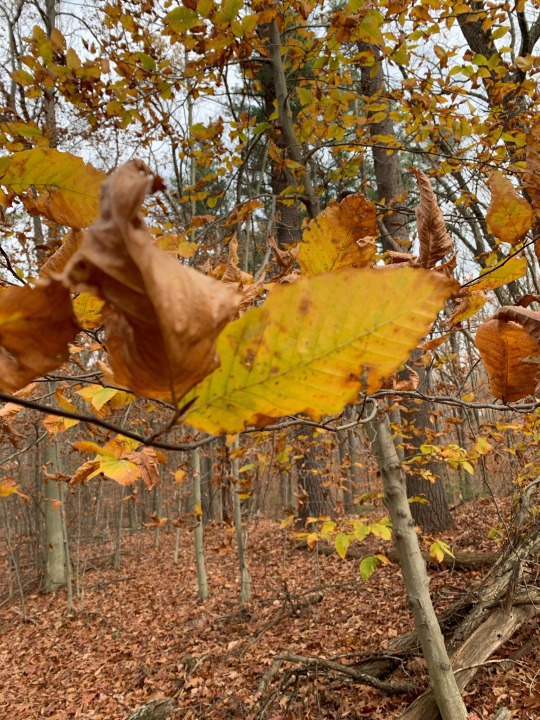
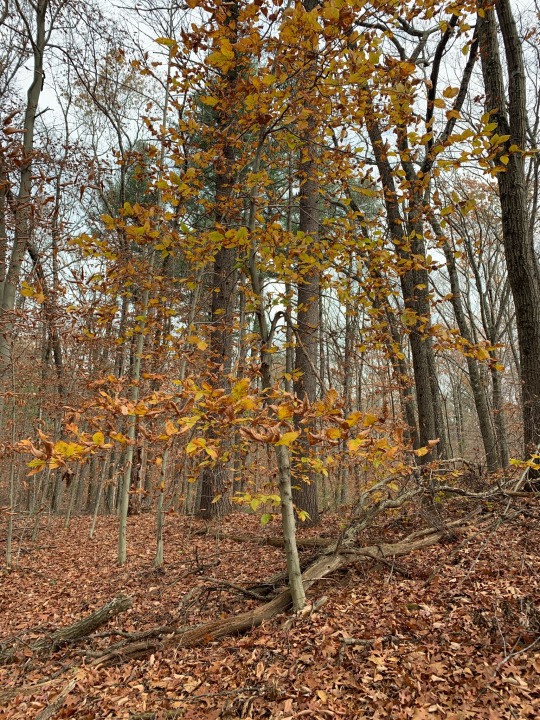
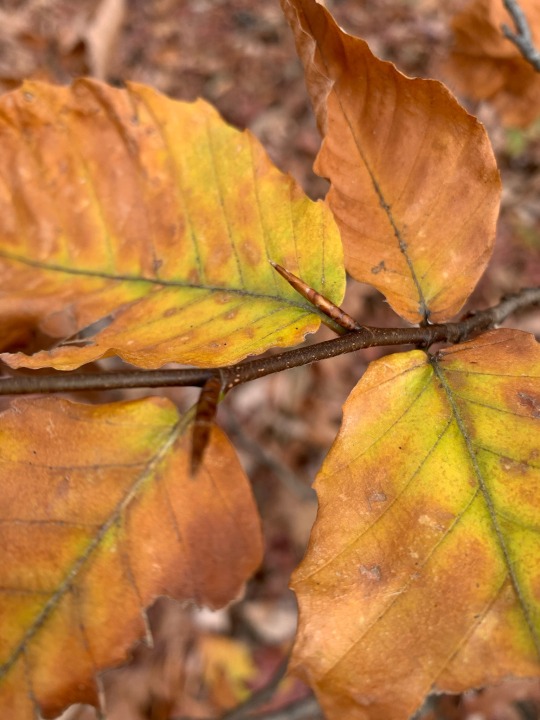
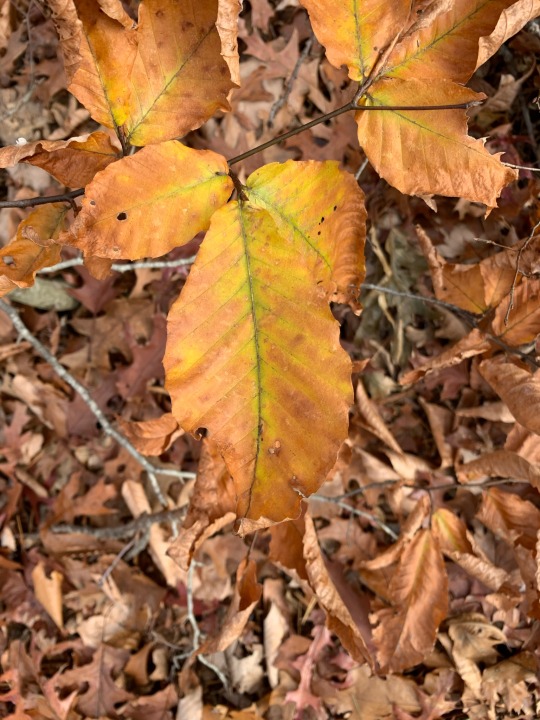

American Beech
Fagus grandifolia
Type: Tree Family: Fagaceae Native Range: Eastern North America Zone: 3 to 9 Height: 50.00 to 80.00 feet Spread: 40.00 to 80.00 feet Bloom Time: April to May Bloom Description: Yellowish-green Sun: Full sun to part shade Water: Medium
BUILD/BEAUTY
These trees are a good example of a plant being able to adapt and move on its own, in response to its environment changing. The beech originated on the southern part of the eastern united states, its smooth bark helped it flourish and not get choked out by other tropical plants. The smooth skin like bark is attractive on these slow growing trees. The Boxford town forest I spotted this in holds a whole grove of these. Many of them have been written on by knives leaving scars in the bark. This beech is young, but will get a 2 out of 3 for its bark characteristic. The leaves are kind of bland, no much too them, as they are a typical simple alternate leaf. For landscape uniqueness, this one gets a 1, as these are very common near me and this was one of many within eye shot.
Bark: (1-3) 3
Leaves: (1-4) 1
Landscape uniqueness: (1-3) 1
Total: 5
This wood has fine hardwood abilities, scoring a 1,300 on the janka hardness test. The tree is commonly used for lumber, veneer, flooring, crates,railroad ties, musical instruments, furniture, turned objects, and other small wooden objects. The wood is commonly made into dimenional lumber, as well as having many other uses in building. The tree should score highly, but it is often overlooked for pine or spruce for a building material. Either way, I am awarding this underdog hardwood an 8 out of 10 for building.
Source:
1. https://www.wood-database.com/american-beech/
2. https://www.thoughtco.com/identify-the-beech-1341874
3. https://www.arborday.org/trees/treeguide/TreeDetail.cfm?ItemID=789
4. http://www.missouribotanicalgarden.org/PlantFinder/PlantFinderDetails.aspx?kempercode=a865
0 notes
Text
Juglans nigra
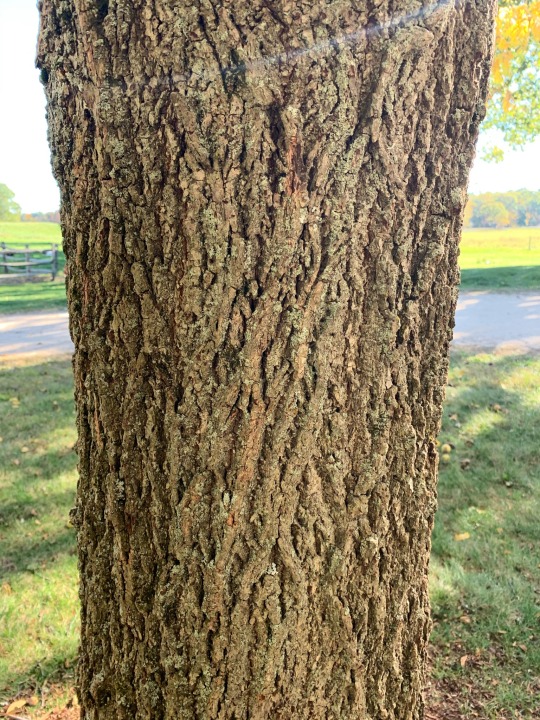
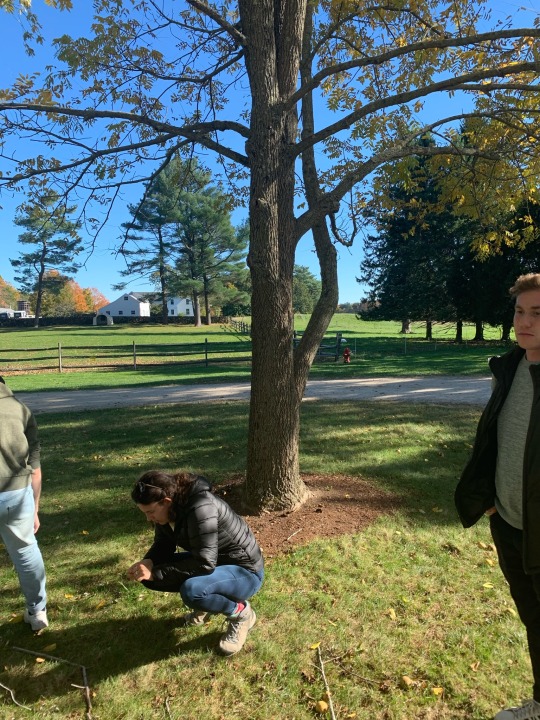


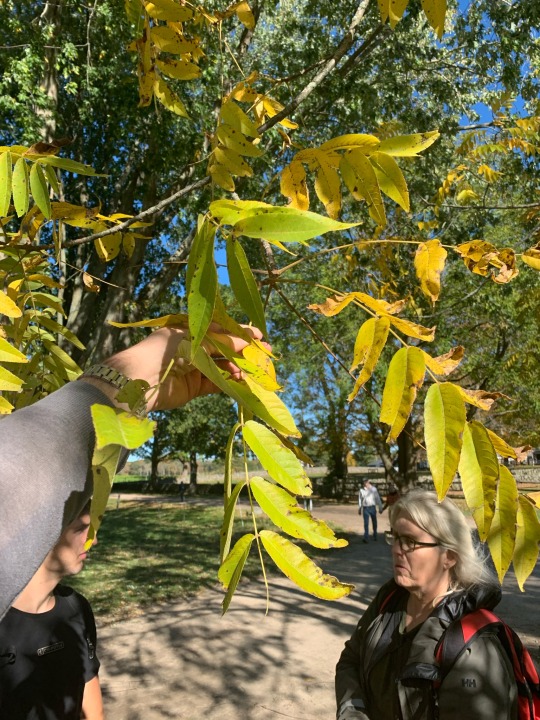
Black Walnut
Juglans nigra
Common Name: black walnut Type: Tree Family: Juglandaceae Native Range: Eastern United States Zone: 4 to 9 Height: 75.00 to 100.00 feet Spread: 75.00 to 100.00 feet Bloom Time: May to June Bloom Description: Yellowish-green Sun: Full sun Water: Medium Maintenance: Medium
BUILD/BEAUTY
This tree is located at Appleton farm in Ipswich MA, and as the name implies, it produces a black walnut fruiting body. The walnut its self is edible, and sought after in some cases. At first glace I though that this was a type of locust due to its type of compound leaves. I quickly realized that the leaves were much bigger than that of a locust. The bark has nice furrowing, slightly deeper than about 75% of other old farm trees. The leaves get the most points in this scoring category due to its good looking unique compound large leaves, and its fruiting bodies. It terms of landscape uniqueness, the black walnut doesn’t exactly excite. The tree blends in well with landscapes, if that is something you are looking for.
Bark: (1-3) 1
Leaves: (1-4) 2
Landscape uniqueness: (1-3) 1
Total: 4
For build quality, black walnut has plenty of great building properties. It is a versatile hardwood commonly found in New England forests. Some of the common uses of this wood include furniture, cabinetry, gun stocks, interior paneling, veneer, turned items, and other small wooden objects and novelties. It would be hard to overstate how popular this wood is terms of woodworking. It probably is the most popular one for ornament. The wood also does have dimensional qualities when it isn’t being made pretty, so It gets a hearty 8 out of 10 on the build scale, due to its many uses AND its ability to be built.
Source:
1. https://www.missouribotanicalgarden.org/PlantFinder/PlantFinderDetails.aspx?kempercode=a875
2. https://www.arborday.org/Trees/TreeGuide/TreeDetail.cfm?Itemid=934
3. https://www.wood-database.com/black-walnut/
0 notes
Text
Quercus Alba



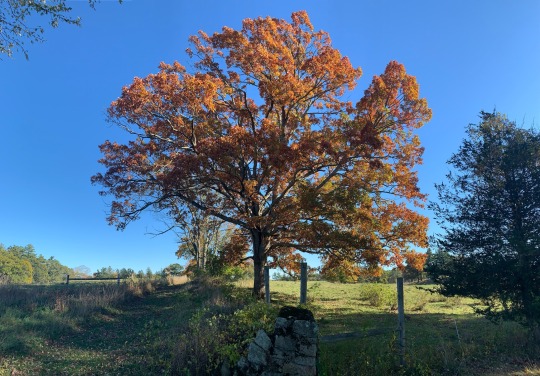

White Oak
Common Name: white oak
Scientific name: Quercus Alba
Type: Tree Family: Fagaceae Native Range: Eastern United States Zone: 3 to 9 Height: 50.00 to 80.00 feet Spread: 50.00 to 80.00 feet Bloom Time: May Bloom Description: Yellowish-green Sun: Full sun
BUILD/BEAUTY
The building qualities of white oak include boat building, veneer, floor boards, some structural joists, cabinetry and barrels. This wood is especially hard and the workability is good as well, meaning that turning this wood into dimensional lumber is not hard to do. The white oak has many uses, and will be scoring high on the score. The wood also is great with not absorbing liquids, so therefore its used well in boat building. This wood will get an 8 out of 10 for build.
For beauty, this tree is not awfully unique. I definitely enjoyed the size and width of this mature example at Appleton Farm. the leaves of oaks, especially this white oak are aesthetically pleasing to me, the rounded lobes are gorgeous. The tree’s bark isn’t spectacular, aside from the fact that this examples trunk is huge, probably 2.5-3 feet across easily. These are pretty common in the landscape as I’ve seen.
Bark: (1-3) 1
Leaves: (1-4) 3
Landscape uniqueness: (1-3) 1
Total: 5
Source:
1. https://www.missouribotanicalgarden.org/PlantFinder/PlantFinderDetails.aspx?kempercode=l930
2. https://www.wood-database.com/white-oak/
3. https://www.arborday.org/trees/treeguide/TreeDetail.cfm?ItemID=883
0 notes
Photo





Swamp White Oak
Quercus Bicolor
Botanical name: Quercus bicolor All Common Names: swamp white oak Family (English): Beech; Oak Family (Botanic): Fagaceae Planting Site: Residential and parks, City parkway, Wide median, Restricted sites Tree or Plant Type: Tree Foliage: Deciduous (seasonally loses leaves) Native Locale: Chicago area, Illinois, North America Landscape Uses: Parkway/street, Shade tree, Specimen Size Range: Large tree (more than 40 feet) Mature Height: 50-60 feet Mature Width: 50-60 feet Light Exposure: Full sun (6 hrs direct light daily) Hardiness Zones: Zone 4, Zone 5 (Chicago), Zone 6, Zone 7, Zone 8
This swamp oak is in the New England Barrier Beach Community, and belongs to the Beech family.
This tree can grow up to 50-80 feet tall, although some examples just barely scrape 95 feet in total height. Their spread is similar to their height, usually 50-60 feet across in final form. It is native to northeastern North America, and thrives in zones 3-8 easily. This Tree likes full sun and can tolerate wet soil, hence the name ‘swamp’ oak. This tree may be a possible eco indicator for land that does occasionally collect water and create a ‘swamp’ effect, although they can be grown elsewhere. The tree is deciduous so it does turn a golden orange in the fall, and the leaves turn a shiny brown when they are ready to fall.
The acorns have a nice little imbricate shell topper to them, as seen in the unripe example photographed. The bark is a thick, scaly off grey color, that looks like it would make great kindling.
In regards to my theme, the Swamp White Oak is a highly versatile building material, having uses in furniture, cabinetry, flooring, and boat building. Although its static structural abilities aren’t as high as some other woods, the oak can clean up nicely as a decorative wood, hence its uses being mostly aesthetic (cabinets, flooring, furniture) It is also highly resistant to moisture so rot doesn’t occur often. This makes goo use in boat construction uses. I will give it a 8/10 for build ability
For beauty, this tree does give off some great fall colors and works well as a street tree when implemented correctly. Also, it does gain some beauty points from its work ability as a exterior finish on cabinets and floors, it earns a 6 out of 10 for beauty.
Bark: (1-3) 2
Leaves: (1-4) 3
Landscape uniqueness: (1-3) 1
Total: 6
Source:
1. https://www.mortonarb.org/trees-plants/tree-plant-descriptions/swamp-white-oak
2. https://www.missouribotanicalgarden.org/PlantFinder/PlantFinderDetails.aspx?kempercode=q330
3. https://www.wood-database.com/swamp-white-oak/
0 notes
Text
【食玩ビルドFACTORY vol.31】発売直前 創動BUILD7!! BUILD8ラインナップを完全公開!!
このサイトの記事を見る
View On WordPress
0 notes
Text
【食玩ビルドFACTORY vol.31】発売直前 創動BUILD7!! BUILD8ラインナップを完全公開!!
このサイトの記事を見る
View On WordPress
0 notes